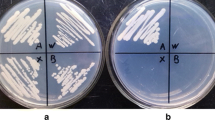Summary
The Candida albicans LEU2 gene was disrupted by substituting lambda DNA for a small deletion within the LEU2 gene. Cotransformation with a selectable URA3 ARS vector was used to introduce a linear fragment containing the disruption into the genome of a C. albicans ura3 deletion mutant. Cotransformants containing the lambda DNA were identified by colony hybridization and the URA3 plasmid was subsequently cured. Leu2 disrupted heterozygotes were detected by Southern hybridization and one disruptant was subsequently treated with UV irradiation. Only one leu2 ura3 mutant (SGY-484) was isolated out of 11,000 mutagenized cells. SGY-484 was transformed to Leu+ with either the C. albicans or Saccharomyces cerevisiae LEU2 gene. Southern hybridization analysis revealed that the mutant is not homozygous for the disruption; the leu2 mutation reverts and is most likely a point mutation. Unexpectedly, an ade2 ura3 mutant was isolated from the same mutagenesis.
Similar content being viewed by others
References
Bach ML, LaCroute F, Botstein D (1979) Evidence for transcriptional regulation of orotidine-5′-phosphate decarboxylase in yeast by hybridization of mRNA to the yeast structural gene cloned in E. coli. Proc Natl Acad Sci USA 76:386–390
Bolivar, F, Rodriguez RL, Greene PJ, Betlach MC, Heynecker HL, Boyer HW, Crosa JH, Falkow S (1977) Construction and characterization of new cloning vehicles. II. A multipurpose cloning system. Gene 2:95–113
Boyer HW, Roulland-Dussoix D (1969) A complementation analysis of the restriction and modification of DNA in Escherichia coli. J Mol Biol 41:459–472
Broach JR, Strathern JN, Hicks JB (1979) Transformation in yeast: development of a hybrid cloning vector and isolation of the CAN1 gene. Gene 8:121–133
Chaleff D, Tatchell K (1985) Molecular cloning and characterization of the STE7 and STE11 genes of S. cerevisiae. Mol Cell Biol 5:1878–1886
Fisher CR (1969) Enzymology of the pigmented adenine requiring mutants of Saccharomyces and Schizosaccharomyces. Biochem Biophys Res Commun 34:306–310
Gaillardin G, Ribet AM, Heslot H (1985) Integrative transformation of the yeast Yarrowia lipolytica. Curr Genet 10:49–58
Gillum AM, Tsay EHY, Kirsch DR (1984) Isolation of the Candida albicans gene for orotidine-5′-phosphate decarboxylase by complementation of S. cerevisiae ura3 and E. coli pyrF mutations. Mol Gen Genet 198:179–182
Harashima S, Shimada Y, Oshima Y (1985) A mutant plasmid with increased stability of holding and polymerization in Saccharomyces cerevisiae. Mol Gen Genet 199:14–20
Hicks JB, Hinnen A, Fink GR (1978) Properties of yeast transformation. Cold Spring Harbor Symp Quant Biol 43:1305–1313
Hohn B, Collins J (1980) A small cosmid for efficient cloning of large DNA fragments. Gene 11:291–298
Holmes DS, Quigley M (1981) A rapid boiling method for the preparation of bacterial plasmids. Anal Biochem 114:193–197
Hughes J, Culver D, White J, Jarvis W, Morgan V, Munn V, Mosser J, Emori T (1983) Nosocomial infection surveillance 1980–1982. Morbid Mortal Weekly Rep 32(455):1–16
Jimencz A, Davies J (1980) Expression of a transposable antibiotic resistance element in Saccharomyces. Nature 287:869–871
Kakar SN, Partridge RM, Magee PT (1983) A genetic analysis of Candida albicans: isolation of a wide variety of auxotrophs and demonstration of linkage and complementation. Genetics 104:241–255
Kelly R, Miller, SM, Kurtz MB, Kirsch DR (1987) Directed mutagenesis in Candida albicans: one-step gene disruption to isolate ura3 mutants. Mol Cell Biol 7:199–208
Kurtz MB, Cortelyou MW, Kirsch DR (1986) Integrative transformation of Candida albicans, using a cloned Candida ADE2 gene. Mol Cell Biol 6:142–149
Kurtz MB, Cortelyou MW, Miller SM, Lai M, Kirsch DR (1987) Development of autonomously replicating plasmids for Candida albicans. Mol Cell Biol 7:209–217
Kurtz MB, Kirsch DR, Kelly R (1988) The molecular genetics of Candida albicans. Microbiol Sci 5:58–63
Maniatis T, Fritsch EF, Sambrook J (1982) Molecular cloning: a laboratory manual. Cold Spring Harbor Laboratory Press, New York
Nellen W, Firtel RA (1985) High-copy-number transformants and co-transformation in Dictyostelium. Gene 39:155–163
Poulter R, Jeffrey K, Hubbard M, Shepherd M, Sullivan PA (1981) Parasexual genetic analysis of Candida albicans by spheroplast fusion. J Bacteriol 146:833–840
Poulter R, Hanrahan V, Jeffrey K, Markie D, Shepherd MG, Sullivan PA (1982) Recombination analysis of naturally diploid Candida albicans. J Bacteriol 152:969–975
Rosenbluh A, Mevarach M, Koltin Y, Gorman JA (1985) Isolation of genes from Candida albicans by complementation in Saccharomyces cerevisiae. Mol Gen Genet 200:500–502
Rudolph H, Koenig-Rauseo I, Hinnen A (1985) One-step gene replacement in yeast by cotransformation. Gene 36:87–95
Sakai K, Sakaguchi J, Yamamoto M (1984) High frequency cotransformation by copolymerization of plasmids in the fission yeast Schizosaccharomyces pombe. Mol Cell Biol 4:651–656
Sarachek A, Rhoads DD, Schwarzhoff RH (1981) Hybridization of Candida albicans through fusion of protoplasts. Arch Microbiol 129:1–8
Sherman F, Fink GR, Hicks JB (1983) Methods in yeast genetics. Cold Spring Harbor Laboratory Press, New York
Shortle D, Novick P, Botsein D (1984) Construction and genetic characterization of temperature-sensitive mutant alleles of the yeast actin gene. Proc Natl Acad Sci USA 81:4889–4893
Siliciano PG, Tatchell K (1984) Transcription and regulatory signals at the mating type locus in yeast. Cell 37:969–978
Silver JM, Eation NR (1969) Functional blocks of the ad1 and ad2 mutants of Saccharomyces cerevisiae. Biochem Biophys Res Commun 34:301–305
Timberlake WE, Boylan MT, Cooley MB, Mirabito PM, O'Hara EB, Willett CE (1985) Rapid identification of mutation-complementating restriction fragments from Aspergillus nidulans cosmids. Exp Mycol 9:344–351
Wernars K, Gosen T, Wennekes BMJ, Swart K, van den Hondel CAMJJ, van den Broek HWJ (1987) Cotransformation of Aspergillus nidulans: a tool for replacing fungal genes. Mol Gen Genet 209:71–77
Whelan WL, Magee PT (1981) Natural heterozygosity in Candida albicans. J Bacteriol 145:896–903
Whelan WL, Partridge RM, Magee PT (1980) Heterozygosity and segregation in Candida albicans. Mol Gen Genet 180:107–113
Author information
Authors and Affiliations
Additional information
Communicated by C.P. Hollenberg
Rights and permissions
About this article
Cite this article
Kelly, R., Miller, S.M. & Kurtz, M.B. One-step gene disruption by cotransformation to isolate double auxotrophs in Candida albicans . Mol Gen Genet 214, 24–31 (1988). https://doi.org/10.1007/BF00340174
Received:
Issue Date:
DOI: https://doi.org/10.1007/BF00340174




